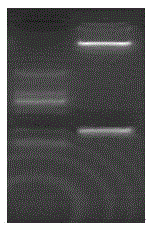amiRNA for inhibiting rice gene OsRboh(LOC_Os01g25820)
A gene and rice technology, applied in the field of genetic engineering, can solve difficult problems such as specific silencing of target genes, off-target effects, etc.
- Summary
- Abstract
- Description
- Claims
- Application Information
AI Technical Summary
Problems solved by technology
Method used
Image
Examples
Embodiment 1
[0022] Example 1: Obtaining the sequence of rice OSBROH gene amiRNA
[0023] Use the tigr online database to find the rice OsRboh (LOC_Os01g25820) gene and download it. According to the online software http: / / wmd3.weigelworld.org to search for possible amiRNA sequences, and according to the reaction thermodynamic parameters, effective free hybridization energy (ΔG) and hybridization energy (ΔGint) and other parameters, finally select “TTAAACAACCGAAGGATACGC” as the target amiRNA sequence. After the candidate amiRNA is obtained, it is reverse-complemented, the T at the 6th position is changed to A, and the T at the 10th position is changed to A to obtain amiRNA*.
Embodiment 2
[0024] Embodiment 2: Construction of rice PHB-OSBROH-amiRNA vector
[0025] The amiRNA and amiRNA* sequences of OsRboh (LOC_Os01g25820) were respectively replaced with the amiRNA and amiRNA* sequences in the backbone OsmiR528 to obtain the OsRboh (LOC_Os01g25820)-amiRNA sequence. According to the principle that the target sequence and the carrier PHB do not repeat restriction sites, the restriction sites BamHI and XbaI were added to the two ends of the OsRboh(LOC_Os01g25820)-amiRNA sequence fragment respectively. Then it was handed over to Shanghai Jierui Bioengineering Co., Ltd. for gene synthesis, and the target sequence was connected to the cloning vector pMD18T.
[0026] BamHI and XbaI digest pMD18T-OsRboh(LOC_Os01g25820)-amiRNA, and the size of the target band can be clearly cut out, see figure 1 . Recover the digested product from agarose gel, connect it with the expression vector PHB digested product with T4DNA ligase, transform Escherichia coli DH5α competent cells, ...
Embodiment 3
[0027] Example 3: PHB-OsRboh(LOC_Os01g25820)-amiRNA transfected Agrobacterium EHA105
[0028] (1) Preparation of Agrobacterium Competent Cells
[0029] Pick a single colony of Agrobacterium EHA105 and inoculate it in 5ml of YEB medium, shake it overnight at 28°C, inoculate it in 50ml of YEB medium at a ratio of 1:100, and continue culturing at 28°C for about 6-7h until OD600=0.4-0.6. Put the bacterial solution on ice for 30min; centrifuge at 5000rpm at 4°C for 5min, discard the supernatant, and suspend the bacteria in 10ml of 0.15M NaCl; 2 , 4°C) to suspend gently, aliquot 200 μl per tube, or add sterile glycerol with a final concentration of 20%, and store at -70°C.
[0030] (2) Transformation and identification of Agrobacterium
[0031] Add 10 μl of plasmid DNA to 200 μl of Agrobacterium competent, mix evenly, ice-bath for 30 minutes, freeze in liquid nitrogen for 3-5 minutes, bathe in water at 37°C for 5 minutes, add 1ml of YEB medium, and shake at 28°C for 3-4 hours. Cent...
PUM
 Login to View More
Login to View More Abstract
Description
Claims
Application Information
 Login to View More
Login to View More - R&D
- Intellectual Property
- Life Sciences
- Materials
- Tech Scout
- Unparalleled Data Quality
- Higher Quality Content
- 60% Fewer Hallucinations
Browse by: Latest US Patents, China's latest patents, Technical Efficacy Thesaurus, Application Domain, Technology Topic, Popular Technical Reports.
© 2025 PatSnap. All rights reserved.Legal|Privacy policy|Modern Slavery Act Transparency Statement|Sitemap|About US| Contact US: help@patsnap.com



